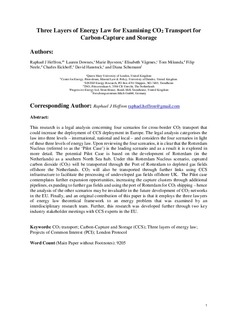| dc.contributor.author | Heffron, R. | |
| dc.contributor.author | Downes, L. | |
| dc.contributor.author | Bysveen, Marie | |
| dc.contributor.author | Brakstad, Elisabeth Vågenes | |
| dc.contributor.author | Mikunda, Tom | |
| dc.contributor.author | Neele, Filip | |
| dc.contributor.author | Eickhoff, Charles | |
| dc.contributor.author | Hanstock, D. | |
| dc.contributor.author | Schumann, Diana | |
| dc.date.accessioned | 2018-04-12T08:40:35Z | |
| dc.date.available | 2018-04-12T08:40:35Z | |
| dc.date.created | 2018-01-09T10:31:04Z | |
| dc.date.issued | 2017 | |
| dc.identifier.issn | 1754-9957 | |
| dc.identifier.uri | http://hdl.handle.net/11250/2493787 | |
| dc.description.abstract | This research is a legal analysis concerning four scenarios for cross-border carbon dioxide (CO2) transport that could increase the deployment of carbon-capture and storage (CCS) deployment in Europe. The legal analysis categorizes the law into three levels—international, national and local—and considers the four scenarios in light of these three levels of energy law. Upon reviewing the four scenarios, it is clear that the Rotterdam Nucleus (referred to as the ‘Pilot Case’) is the leading scenario and as a result it is explored in more detail. The potential Pilot Case is based on the development of Rotterdam (in the Netherlands) as a southern North Sea hub. Under this Rotterdam Nucleus scenario, captured CO2 will be transported through the Port of Rotterdam to depleted gas fields offshore the Netherlands. CO2 will also be transported through further links using CCS infrastructure to facilitate the processing of undeveloped gas fields offshore UK. The Pilot case contemplates further expansion opportunities, increasing the capture clusters through additional pipelines, expanding to further gas fields and using the port of Rotterdam for CO2 shipping—hence the analysis of the other scenarios may be invaluable in the future development of CO2 networks in the EU. Finally, and an original contribution of this article is that it employs the three lawyers of energy law theoretical framework to an energy problem that was examined by an interdisciplinary research team. Furthermore, this research was developed further through two key industry stakeholder meetings with CCS experts in the EU. | nb_NO |
| dc.language.iso | eng | nb_NO |
| dc.rights | Navngivelse 4.0 Internasjonal | * |
| dc.rights.uri | http://creativecommons.org/licenses/by/4.0/deed.no | * |
| dc.title | Three layers of energy law for examining CO2 transport for carbon-capture and storage | nb_NO |
| dc.type | Journal article | nb_NO |
| dc.type | Peer reviewed | nb_NO |
| dc.description.version | acceptedVersion | nb_NO |
| dc.rights.holder | Authors have copyright to accepted version | nb_NO |
| dc.source.journal | Journal of World Energy Law and Business | nb_NO |
| dc.identifier.doi | 10.1093/jwelb/jwx035 | |
| dc.identifier.cristin | 1538530 | |
| dc.relation.project | EC/H2020/657263 | nb_NO |
| cristin.unitcode | 7548,70,0,0 | |
| cristin.unitcode | 7548,60,0,0 | |
| cristin.unitname | Termisk energi | |
| cristin.unitname | Gassteknologi | |
| cristin.ispublished | true | |
| cristin.fulltext | postprint | |
| cristin.qualitycode | 1 | |

